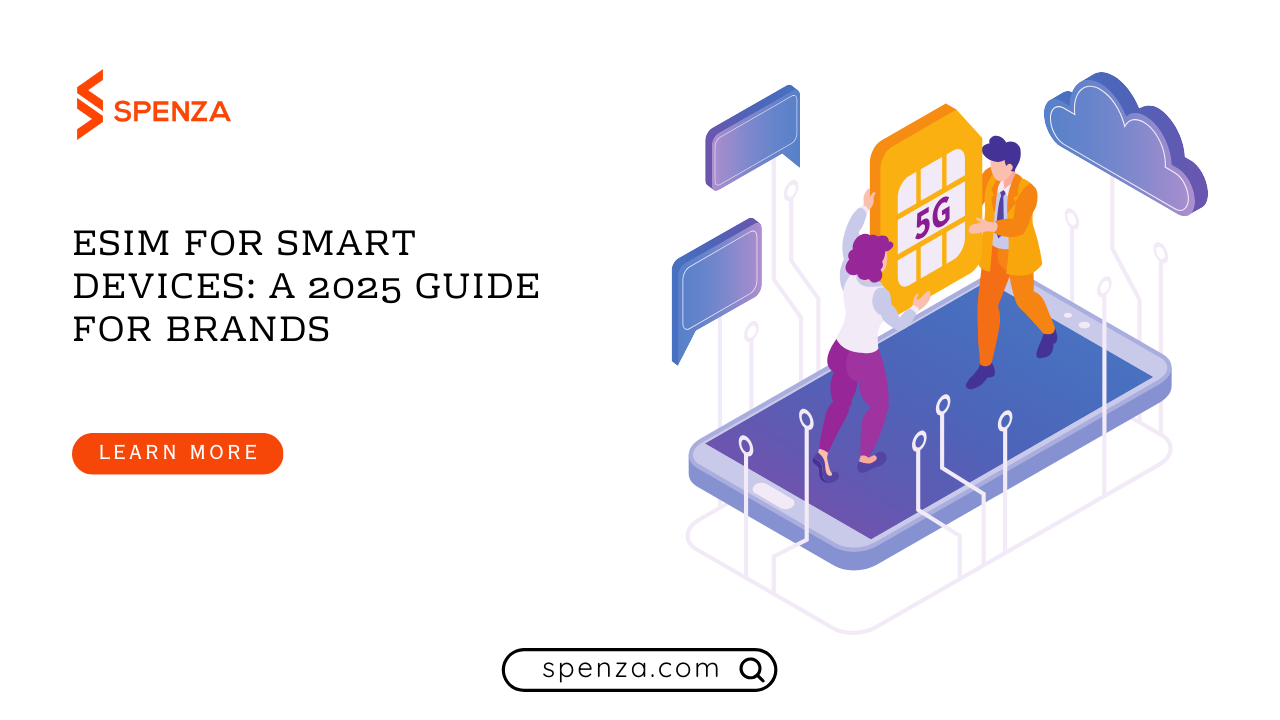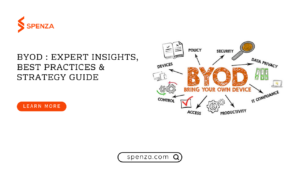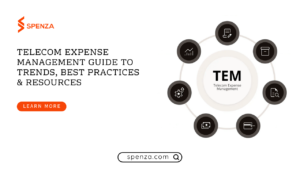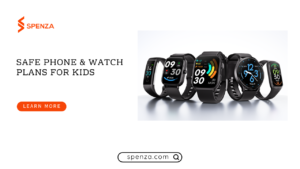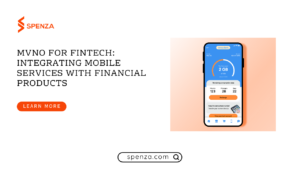TL;DR (For Brands)
- eSIM for smart devices is the new standard in 2025. Nearly all premium devices use it.
- Physical SIM-only devices cause manufacturing and logistics headaches.
- eSIM for device manufacturers means a single SKU for global markets.
- Global connectivity for IoT is simple with remote provisioning.
- Recurring revenue from devices is now possible with branded data plans.
- The smart way to handle eSIM implementation is to partner with an expert platform like Spenza.
Quick look: eSIM for smart devices transforms connectivity from fixed hardware to flexible software. In 2025, brands use it to cut manufacturing costs, expand global reach, improve customer experience, and create recurring revenue from devices.
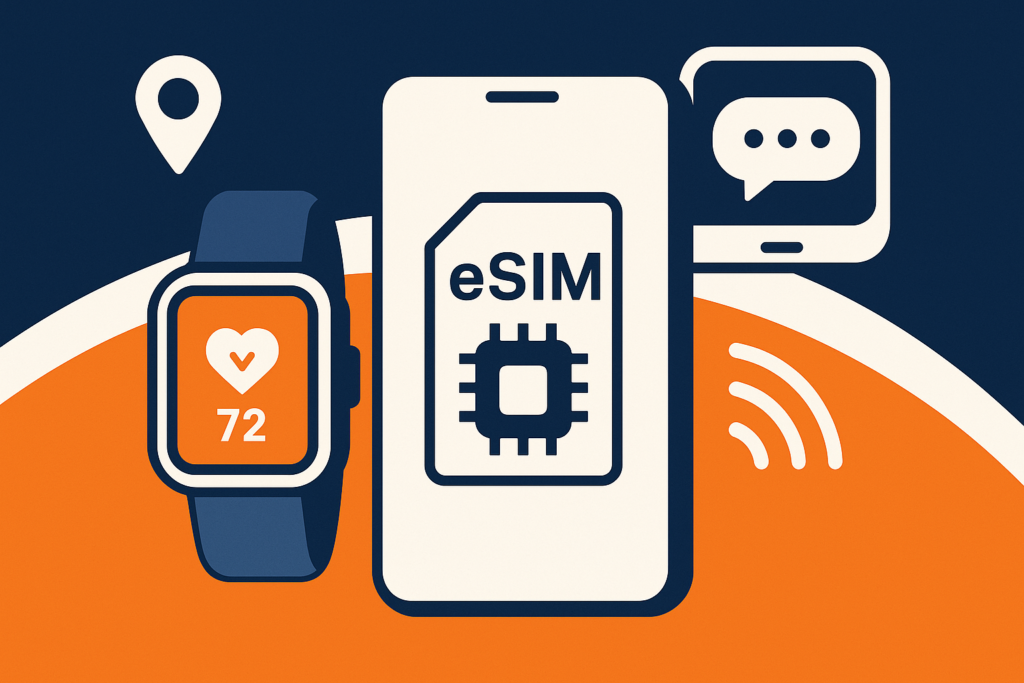
Introduction: Why Every Connected Device in 2025 Needs eSIM Built-In
Why would any brand launch a connected device today that still depends on a plastic SIM card? The numbers say it all. By 2025, 99% of smartwatches, 73% of laptops, and almost half of smartphones will use eSIM.
This change started years ago when brands like Apple launched eSIM-only devices in major markets. Today, any connected product without eSIM for smart devices looks outdated, both to consumers and to the global supply chain partners who expect software-driven connectivity from the start.
Yet some brands still build hardware that depends on SIM slots. That decision means manufacturing multiple SKUs for different regions, stocking different SIMs, and losing the ability to offer global connectivity for IoT without carrier-specific hardware. It also means missing the opportunity for recurring revenue from devices through branded data services.
This guide shows exactly how to use eSIM for smart devices in your products, why it’s now a business strategy, not a feature, and how to get it right.
What Would You Get by the End of the Article?
- A clear explanation of what an eSIM is from a brand’s point of view.
- The 5 business-changing benefits of eSIM for device manufacturers.
- How global connectivity for IoT works in real terms.
- How recurring revenue from devices becomes a reality with eSIM.
- The difference between the hard and smart ways of eSIM implementation.
- Why Spenza is the partner that makes eSIM profitable and simple.
What is an eSIM?

The Hardware – The Chip
From a manufacturing view, what is an eSIM? It’s a small, programmable chip, permanently soldered to your device’s motherboard. There is no SIM tray. This saves space for better batteries or components and makes devices more durable. Without a slot, water and dust resistance improves.
The Software – The Profile
The real answer is in the profile. This is the digital carrier plan stored on the chip. Devices can hold multiple profiles, up to eight on many consumer devices. Each profile can be installed, switched, or deleted remotely through secure provisioning. This gives you global flexibility without shipping different hardware for each carrier.
The Shift – Hardware to Software
eSIM for smart devices changes connectivity from a fixed hardware element to a software-controlled feature. A single SKU can serve any market, with connectivity profiles downloaded after shipping. That flexibility matters for global connectivity for IoT, where devices may operate in multiple countries over their lifetime.
The 5 Game-Changing Benefits of eSIM for Device Manufacturers
eSIM for smart devices does more than replace a SIM card, it transforms how you build, sell, and support your products. You cut SKUs, ship globally, create recurring revenue from devices, deliver instant activation, and keep fleets current with remote updates.

1. Radically Simplified Manufacturing & Logistics
With eSIM for device manufacturers, you ship one model worldwide. No more separate SKUs for different SIM formats or carriers. You also avoid sourcing and installing SIM cards for each batch.
| Traditional SIM | eSIM for Smart Devices |
|---|---|
| Multiple SKUs for each carrier | One SKU for all markets |
| SIM tray and slot required | No slot, soldered chip |
| Manual SIM insertion in factory | Profile download over the air |
| Carrier-specific hardware | Carrier-agnostic hardware |
This saves production time, reduces stock management, and prevents the common problem of mismatched SIMs in certain markets.
2. Instant Global Reach
Devices can be shipped anywhere and connect locally right away. No need for roaming deals or preloaded SIMs. eSIM support exists in 123+ countries , with operators in over 190 supported through multi-carrier platforms like Spenza’s global connectivity services.
This means your device is ready for global connectivity for IoT without redesigning hardware or locking into one carrier.
3. New Recurring Revenue Streams
Recurring revenue from devices is now possible. The global eSIM connectivity services segment accounted for 87.5% of the eSIM market in 2024. With eSIM, you can sell branded data plans directly, whether for first-time activation, backup service, or travel connectivity.
For example, a wearable brand can offer an optional global plan that works in 100+ countries. That’s margin-rich revenue, month after month, long after the initial device sale. Spenza’s branded eSIM marketplace makes this setup fast for OEMs.
4. A Frictionless Customer Experience
With eSIM for smart devices, users power on the device and connect instantly. No store visits. No SIM cards to insert. Just a QR code or in-app activation. This ease is a selling point, especially for premium devices.
It also enables features like switching carriers in minutes or adding a secondary profile for travel. That’s the kind of smooth onboarding that drives customer satisfaction and repeat purchases.
5. Future-Proof Your Fleet
Over time, networks change, 3G sunsets, new 5G standards roll out. eSIM profiles can be updated remotely. That means your devices stay connected and compliant without hardware swaps.
For mission-critical IoT, you can store multiple profiles for network redundancy. When one carrier is down, the device can switch automatically.
How to Implement eSIM: The Hard Way vs. The Smart Way
The Hard Way
You can try building your own eSIM infrastructure. That means negotiating with carriers in each market, building an RSP (Remote SIM Provisioning) platform, and managing dozens of technical integrations. This takes years and massive resources.
The Smart Way
The better option is to partner with an expert. This is where Spenza’s IoT eSIM solutions come in. You get one API for global carrier access, plus the tools to manage and monetize your eSIM fleet.
Here’s how they compare:
| Criteria | The Hard Way (DIY) | The Smart Way (Partner) |
|---|---|---|
| Carrier Agreements | Negotiate with dozens of carriers worldwide. It takes months or years. | One agreement for global coverage through a single partner. |
| Technical Integration | Build RSP infrastructure from scratch. Complex and costly. | Ready API and management tools available from day one. |
| Time to Market | Often 18–36 months before launch. | Go live in weeks or months. |
| Scalability | Every new region adds more work and contracts. | Built-in multi-country support from the start. |
| Ongoing Maintenance | Continuous updates, security patches, compliance work. | Partner handles updates, compliance, and provisioning. |
| Revenue Potential | Limited by how fast you expand carrier coverage. | Immediate ability to sell branded plans globally. |
Key Factors to Consider Before Choosing Your eSIM Approach
Whether you go the hard way or the smart way, certain factors decide how successful your eSIM implementation will be. For device manufacturers, these are not optional checks; they directly impact cost, speed, and customer experience.

1. Target Markets and Regulations
Different countries have different rules for eSIM provisioning. Some require local carrier profiles for long-term use. Knowing these ahead of time avoids compliance issues and costly delays.
2. Device Category and Lifecycle
A consumer wearable with a 2–3 year lifecycle has different needs than an industrial IoT sensor expected to run for 10+ years. Think about profile update frequency, redundancy, and network technology upgrades.
3. Carrier Availability and Network Quality
eSIM for smart devices works best when you have access to multiple carriers in a region. This ensures strong coverage and competitive rates for your customers.
4. Monetization Strategy
Decide if you want to offer recurring revenue from devices via branded plans. This impacts your platform choice because not every provider supports direct-to-consumer plan sales.
5. Technical Resources
Managing eSIM integrations internally requires telecom expertise. If you don’t have that in-house, working with a partner that offers global connectivity for IoT plus monetization tools is the smarter move.
6. Customer Experience Goals
Think about how activation will work for your end users. Will they scan a QR code, tap a button in an app, or have service pre-activated out of the box? The smoother this is, the stronger your brand impression.
Spenza: Your Turnkey Platform for eSIM Success
Spenza is not just another telecom vendor. It is a modern MVNE built for both traditional MVNOs and IoT-first deployments. For a device brand, this means you get the tools, the carrier access, and the business model to make eSIM for smart devices work profitably from day one.
Why Spenza is Different
Most providers will give you carrier access and stop there. Spenza delivers an entire cloud-native, API-first platform that includes:
- Integrated SIM and eSIM provisioning.
- A customizable billing engine for your branded data plans.
- Real-time usage analytics to track every connected device.
- Carrier management tools to handle connectivity across over 190 countries.
This makes Spenza perfect for OEMs, because it handles both the technical eSIM implementation and the business-side monetization in one system.
1. Single Integration for Global Reach
With Spenza, you don’t need to sign a deal with every carrier. You get one API connection that gives you multi-carrier coverage in over 190 countries. This is critical for global connectivity for IoT, because devices may move between countries or operate in multiple regions during their lifespan.
If you build physical SIM-only devices, adding a new market can mean redesigning hardware. With Spenza’s eSIM for device manufacturers, adding a new country is a software change, no new SKU, no new supply chain headaches.
2. Managing and Monetizing Connectivity
Selling connectivity is no longer just for mobile operators. With Spenza, you can offer recurring revenue from devices through your own branded data plans. The platform includes:
- An online marketplace where customers buy or top-up plans.
- White-label branding so the plan looks and feels like your product’s service.
- Integration with your device UI for seamless activation.
For example, a smart camera manufacturer could bundle one year of service, then offer monthly renewals directly through the app. You keep the customer relationship and the recurring revenue from devices instead of sending it all to a third-party carrier.
You can see how Spenza’s branded eSIM marketplace turns hardware sales into long-term service revenue without building a telecom operation from scratch.
3. Full Control Over eSIM Profiles
Spenza’s dashboard lets you see and control every eSIM in your fleet. You can:
- Activate, pause, or switch profiles remotely.
- Push new profiles to improve coverage or pricing.
- Pre-load bootstrap profiles for instant activation in the field.
This control is essential for mission-critical deployments. For example, if a carrier in a certain market suffers an outage, you can switch all affected devices to a backup profile instantly.
How Spenza Makes eSIM Implementation Easy
When you use Spenza, the steps to bring eSIM for smart devices to market are straightforward:
- Integrate the API – Connect your device firmware or platform to Spenza’s system.
- Configure Plans – Choose the data packages you want to offer customers.
- Test and Launch – Activate sample devices to ensure smooth provisioning.
- Go Live – Ship one global SKU and let customers activate instantly anywhere.
- Monetize – Sell and manage recurring revenue from devices through the platform.
Why OEMs Choose Spenza
- Speed – Launch global-ready devices in months, not years.
- Simplicity – One integration, one platform, all carriers.
- Profitability – New revenue from connectivity services.
- Scalability – Add markets without touching hardware.
- Reliability – Carrier-grade provisioning and compliance.
When you compare this to the hard way, it’s clear that Spenza eliminates the biggest risks and delays of eSIM implementation.
You can explore more about how Spenza supports IoT eSIM deployments and why it’s the right choice for OEMs moving to eSIM for smart devices.
Conclusion: Embrace the Future of Device Connectivity
In 2025, eSIM for smart devices is not a nice-to-have. It’s the standard for connected products that need to work anywhere, update over the air, and generate ongoing revenue. Brands sticking to SIM trays will lose out on speed, cost efficiency, and customer satisfaction.
Spenza gives you everything you need to make the switch without the years of carrier negotiations and infrastructure building. You get global connectivity for IoT, recurring revenue from devices, and full control over your fleet from one dashboard.
FAQs
An eSIM is a small chip soldered inside your device that stores carrier profiles digitally. Unlike a SIM card, it doesn’t need to be physically inserted or swapped. Profiles are downloaded securely over the air.
You ship one SKU globally. There’s no need for different models for each carrier or region, and no SIM card logistics. This cuts production complexity and speeds up market launches.
Yes. With a platform like Spenza, you can sell your own branded plans for your devices, creating recurring revenue from devices without building your own telecom infrastructure.
Your device can download a local carrier profile wherever it operates. This avoids roaming fees and ensures strong local network performance.
With Spenza’s API-first platform, many OEMs go from integration to launch in just a few months instead of years.
No. That’s the point of partnering with an MVNE like Spenza—they bring network, compliance, and billing expertise so you can focus on brand, product, and go‑to‑market.
Ready to move your devices into the future? Contact Spenza today to schedule your eSIM strategy session and see how fast and profitable your eSIM launch can be.
